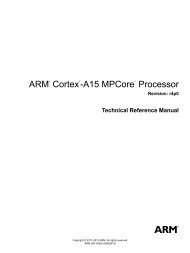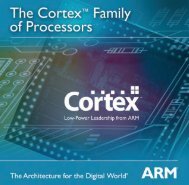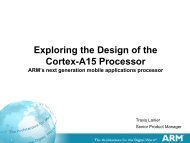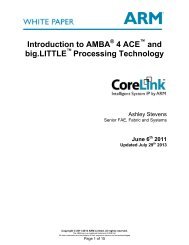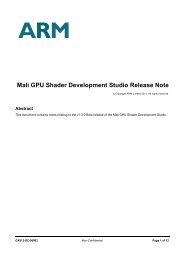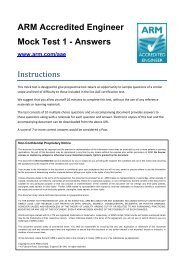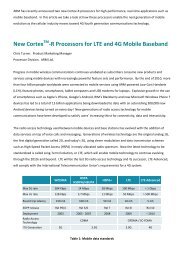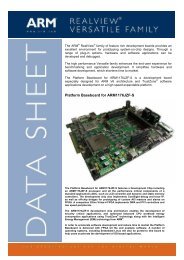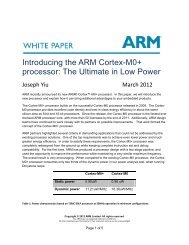32‐Bit Microcontroller Code Size Analysis - Arm
32‐Bit Microcontroller Code Size Analysis - Arm
32‐Bit Microcontroller Code Size Analysis - Arm
You also want an ePaper? Increase the reach of your titles
YUMPU automatically turns print PDFs into web optimized ePapers that Google loves.
you can define the SysTick registers as:<br />
typedef struct<br />
{<br />
volatile unsigned int CTRL;<br />
volatile unsigned int LOAD;<br />
volatile unsigned int VAL;<br />
unsigned int CALIB;<br />
} SysTick_Type;<br />
#define SysTick ((SysTick_Type *) 0xE000E010)<br />
By doing this, you only need one address constant to be stored in the program ROM. The register<br />
accesses will be using this address constant with different address offsets for different registers. If a<br />
sequence of hardware register accesses is required for a peripheral, using a data structure can<br />
reduce code size as well as improve performance. Most 8‐bit microcontrollers do not have the same<br />
addressing mode feature which can result in a much larger code size for the same task.<br />
Conclusions<br />
32‐bit processors provide equal or more often better code size than 8‐bit and 16‐bit architectures<br />
whilst at the same time delivering much better performance.<br />
For users of 8‐bit microcontrollers, moving to a 16‐bit architecture can solve some of the inherent<br />
problems with 8‐bit architectures, however, the overall benefits of migrating from 8‐bit to 16‐bit is<br />
much less than that achieved by migrating to the 32‐bit Cortex processors.<br />
As the power consumption and cost of 32‐bit microcontrollers has reduced dramatically over last<br />
few years, 32‐bit processors have become the best choice for many embedded projects.<br />
Reference<br />
The following articles on MSP430 are referenced:<br />
Reference<br />
1 MSP430 Competitive Benchmarking<br />
http:// focus.ti.com/lit/an/slaa205c/slaa205c.pdf<br />
2 Efficient Multiplication and Division Using MSP430<br />
http://focus.ti.com/lit/an/slaa329/slaa329.pdf<br />
ARM <strong>Microcontroller</strong> <strong>Code</strong> <strong>Size</strong> <strong>Analysis</strong> | Conclusions 16



